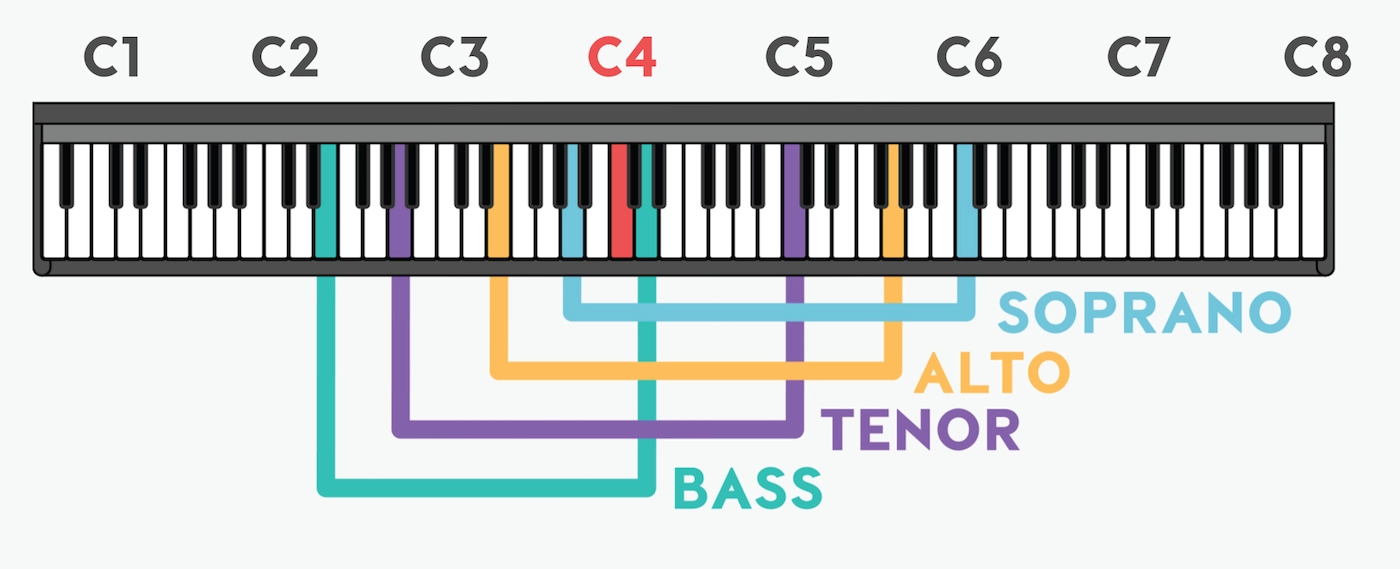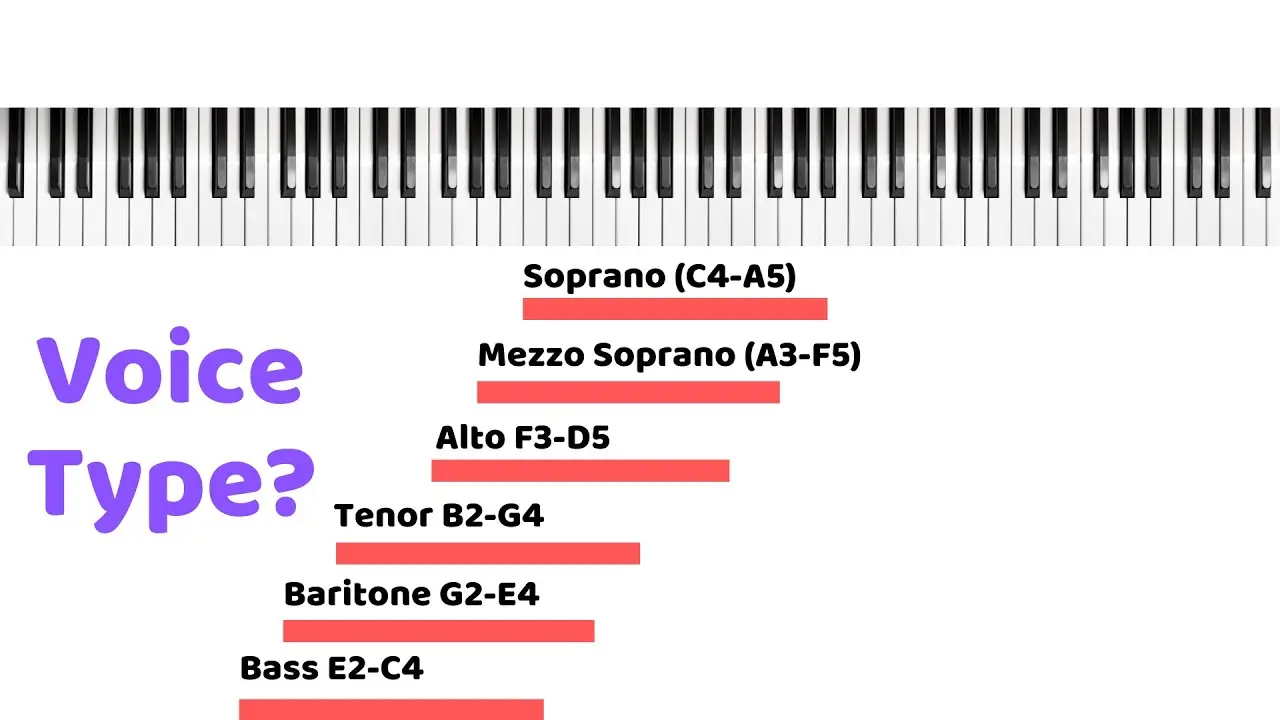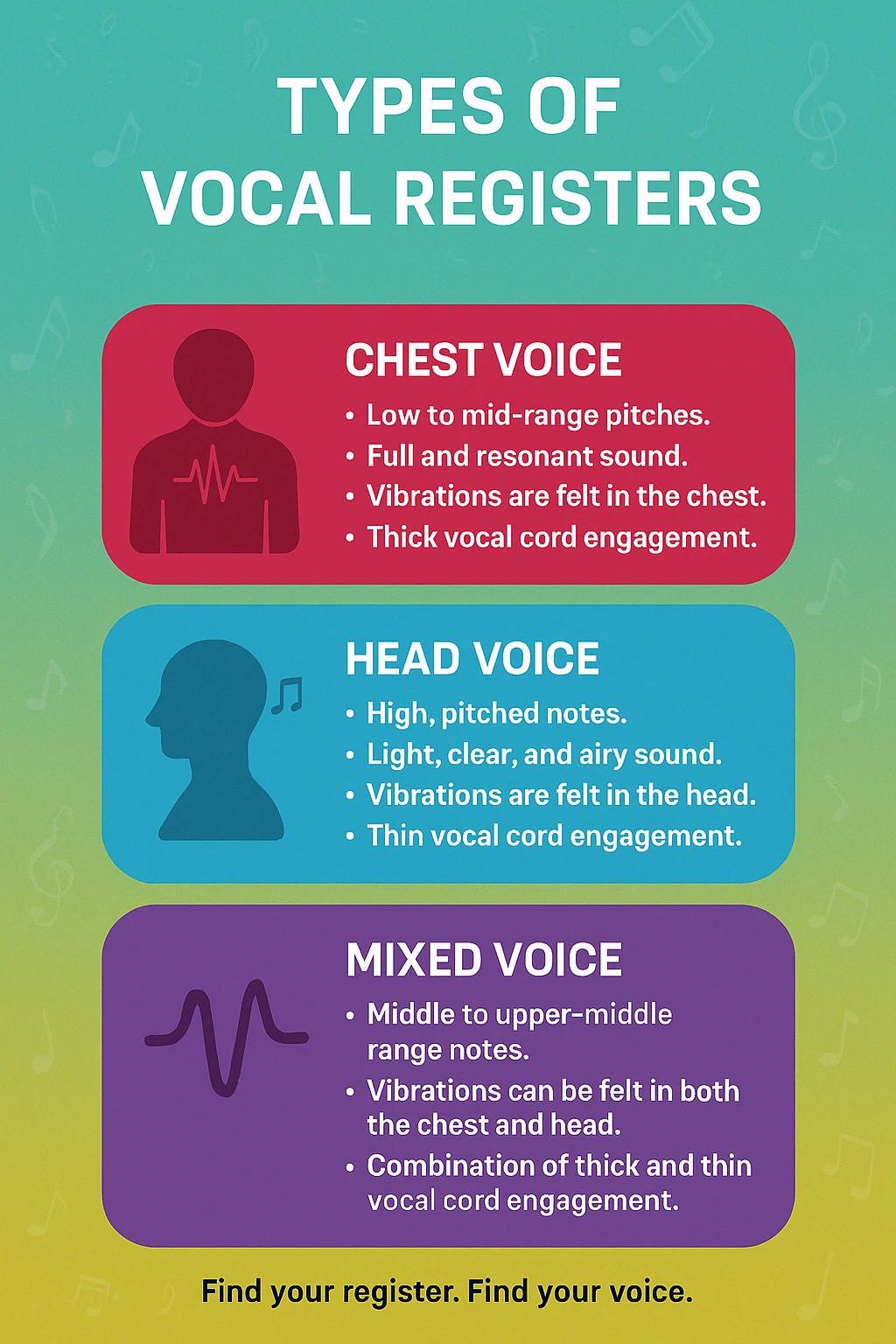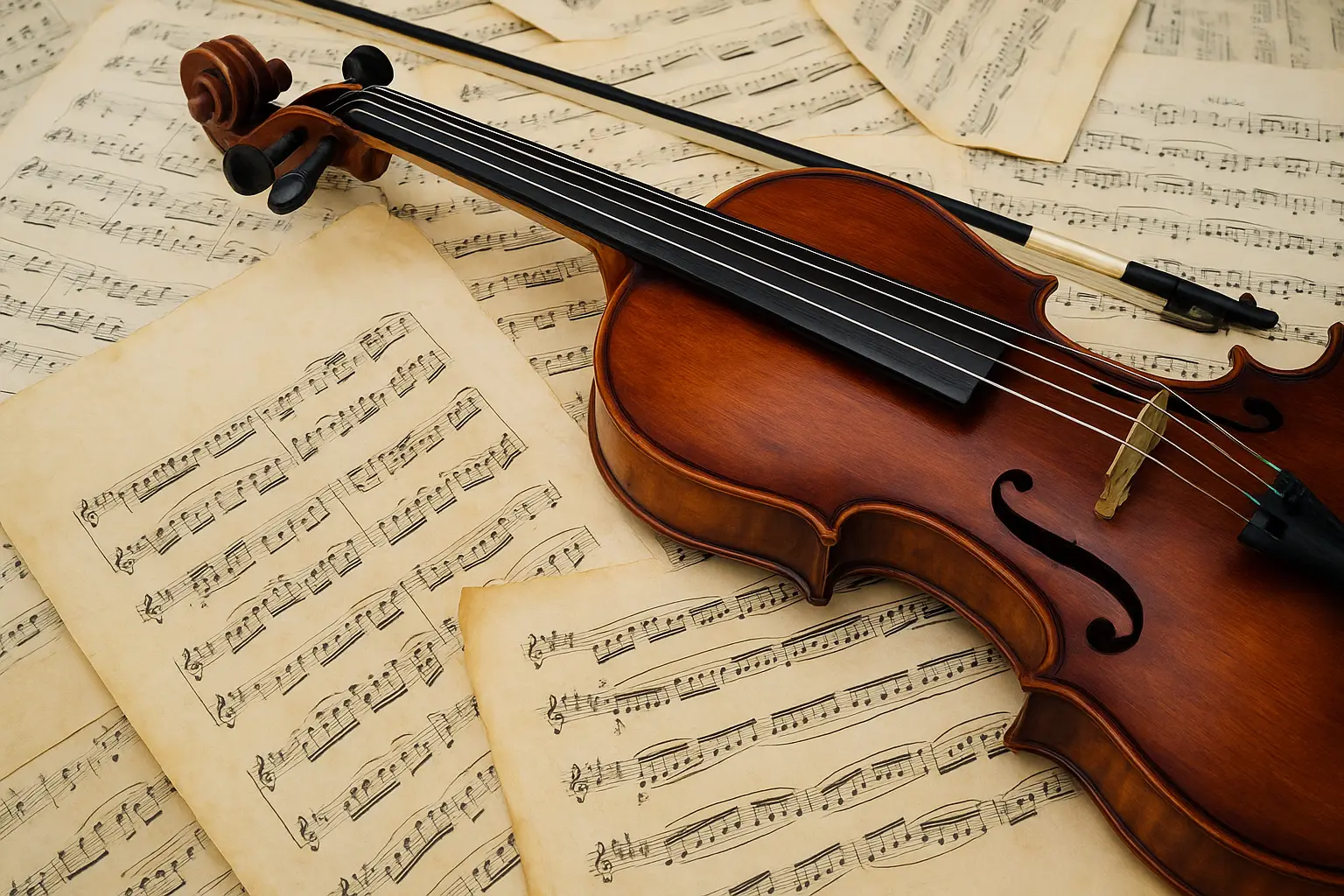Let’s make this easy: your voice is not a mystery box. It’s an instrument. A wonky, wonderful, human instrument.
In this guide, I’ll show you a fast, accurate vocal range test, explain exactly how to find your vocal range (or, if you’ve been wondering how to find my vocal range, same thing), how to read the notes you hit, and how to expand that range without shredding your cords.
But remember, learning sticks better when we smile. (Also, you’re “built different,” which is why your routine should match your biology, not anyone else’s. Try, test, keep what works. Ditch what doesn’t.)
What “vocal range” actually is (and what it isn’t)
Your voice is simply mechanics plus personality. Technically, your vocal range is the span from your lowest clear, sustainable pitch to your highest.
Artistically, it’s the playground where you decide what stories your voice can tell: a velvet low note, a clean high C for a musical theatre climax, or the sudden whistle tone you brag about to friends because Ariana Grande made it cool.
It’s written like a math interval, e.g., C3–G5, using note letters plus octave numbers (C below middle C is C3; the “high C” above middle C is C5). If you’re fuzzy on the note numbers, you’re not alone.
“Clearly” is the operative word. That croaky mumble you make first thing in the morning doesn’t count, and neither does the squeal you produce by clenching everything above your collarbone. We’re talking about tones you can land, hold, and repeat without your larynx filing for workers’ comp.
From a physiological angle, your range is set by the size and tension of your vocal folds, the way your resonators (mouth, throat, nasal cavities) shape sound, and how skillfully you manage airflow.
Artistically, it’s the playground where you decide what stories your voice can tell: a velvet low note, a clean high C for a musical theatre climax, or the sudden whistle tone you brag about to friends because Ariana Grande made it cool.

Pro tip: range ≠ personality. Two singers may share identical note boundaries yet sound nothing alike because of tone, phrasing, or even emotional intent. Your range is your map; your style is how you travel.
The Home Experiment (aka the Vocal Range Test)
Let’s find out what your vocal range is.
- Method 1- If you can’t use a piano, don’t worry. Use a vocal range app.
- Method 2 - If you can pitch-match: Use a piano or keyboard.
Method 1: Use Apps
Apps you can use to find your vocal range:
- VocalRange Vocaberry
- Vocal Range Finder - Sing Whiz (iOS)
- Vocal Monitor (Android)
These apps record you and show your range as the lowest note → the highest note.
Using a Tuning App to Find Your Exact Vocal Range
Method 2: Pitch-Match (Using Piano)
(Skip if you don’t play piano or can’t pitch-match with ear)
Before we go hunting for new notes, we need to chart where your voice already lives. Luckily, you just need a quiet room, a piano or keyboard app, and about five minutes of curiosity.

1. Prime the instrument.
Warm up gently: hum through a scale, slide on a lip trill, sigh a light “ng” up and down. This wakes up your cords and spares you from judging yourself on a half-asleep voice. (Need ideas? Check our vocal warmups guide.)
This is the easiest way to determine your vocal range at home. Many singers use
an online vocal ranges chart to visualize the notes they’ve found.
2. Find your floor.
Start around your speaking pitch, roughly C4 for women, C3 for men, and move down by semitones. Keep each note steady on an open “ah.” Stop when the sound turns into a rumble or disappears. Write down the last note that stayed clear: that’s the bottom of your range.
3. Find your ceiling.
Go back to the middle, then inch upward by half steps. Around the top of chest voice you’ll feel a shift; that’s where head voice or falsetto wants to take over. Allow it, just keep aiming for a clean pitch rather than a heroic yell. Mark the highest note you can sustain without strain.
Still wondering, ‘how do I find my vocal range?’ or ‘how do I know my vocal range?’ Start by sliding slowly from low to high, record the extremes, and label them against a chart.
4. Note your “living room.”
Teachers call it the Prima Voce or tessitura, the 12–18 notes where singing feels as easy as speaking. This is the part of your range you’ll actually use most. Expanding beyond it is fun, but this middle is where songs get sung.
If you want to geek out, compare your numbers to famous voices:
- A comfortable F3–F5 puts you near Adele’s territory.
- Around C3–C5 aligns with Bruno Mars.
- Anything close to E2 on the low end means you share real estate with Johnny Cash.
And if you find yourself above A5? Congratulations, you’re exploring the neighborhood of Mariah and Ariana. Just don’t expect to redecorate their whistle register overnight.
Voice Types and the “Gears” Inside Your Range
Once you’ve mapped the top and bottom of your voice, the next question is inevitable: “Okay… but what am I?”
Singers love a label, and music history has happily supplied plenty: soprano, alto, tenor, bass, mezzo-soprano, baritone, neat boxes that make choir seating charts easier.
But here’s the secret most seasoned teachers know: these boxes are guidelines, not law. Your voice is a living instrument; it doesn’t always behave like a tidy chart.
The Classic “Six-Pack” of Voice Types
- Soprano vocal range: High female voice, living roughly from C4 to A5 or higher. Think clear top notes, melody lines, and that bright sparkle you hear in Maria Callas, Renée Fleming. Pop equivalent: Ariana Grande.
- Mezzo-Soprano vocal range: The warm middle sister, hanging around A3–F5. This is Adele country: velvety mids with enough lift for strong choruses. Classical: Cecilia Bartoli. Modern: Adele.
- Contralto (Alto) vocal range: Low female voice, F3 (to D5) down into the 3rd octave. Rare and dark, like Marian Anderson. Modern: Tracy Chapman, Toni Braxton.
- Tenor vocal range: Upper male voice, C3–A4+. Classical: Luciano Pavarotti, Plácido Domingo. Modern: Freddie Mercury, Justin Bieber.
- Baritone vocal range: Middle male range, G2–E4. Classical: Dmitri Hvorostovsky. Modern: John Mayer, Elvis.
- Bass vocal range: The subwoofer of voices, E2–C4, beloved by choirs and anyone secretly wishing to narrate movie trailers. Samuel Ramey and Avi Kaplan (Pentatonix) possess this rare ability.
Why this matters: Knowing your type helps you pick songs that fit rather than punish. But don’t chain yourself to it; range is elastic when coached well.

What is the typical female vocal range?
A female vocal range is usually described in three broad categories: soprano, mezzo-soprano, and alto (or contralto).
For a concrete example, take Sabrina Carpenter vocal range: she typically covers about B2 to F#5, placing her in the pop-mezzo/soprano space.

That means she can hit both relatively low notes (for a female singer) and some strong high territory without relying on extreme whistle work. Her voice shows how fluid these categories are. She has enough low to lend warmth, enough high to sparkle.
Remember: these classifications are helpful for choosing songs, keys, and working safely. They aren’t rigid cages. Use what fits your voice best, and give yourself permission to explore beyond it.
Famous Voices & Range Examples: Who Do You Sound Like?
How do you fit in? Whose range are you closest to?
- Mariah Carey vocal range: Mariah Carey’s vocal range is legendary: five octaves from G2 up to a glass-shattering G7. Her whistle notes prove just how far careful training (and rare genetics) can go.”
- Freddie Mercury vocal range: If you’re fascinated by the Freddie Mercury, their vocal range is about four octaves; you’ll notice his power lived in the tenor zone, with extra grit at the edges.
- Axl Rose vocal range: Rock fans point to the Axl Rose, who’s known for stretching from deep bass growls to piercing soprano screams; it’s proof that range isn’t tied to one genre.
- Taylor Swift vocal range: Taylor Swift’s can extend roughly three octaves and sits inside a light-lyric soprano space, perfect for storytelling melodies.
Registers: Your Voice’s Gearbox
Imagine your voice as a car with several gears:
- Chest voice is first gear. Solid, warm, where you speak and sing lower notes.
- Head voice is the higher gear. Lighter, resonant, often where women sing high melodies or men float a clear upper line.
- Falsetto (mostly for guys) is a feathery overdrive, airy but great for color.
- Mix is the clutch allowing you to blend chest and head so you don’t “stall” at the passaggio (that notorious break).
- Whistle register (aka Dolphin Vocalization) is Formula One territory: Minnie Riperton hang out here. Fun, but not required for 99% of repertoire.

Most cracks happen between gears, not at the very top or bottom. A smooth slide (a siren or “aah” glide) across that handoff teaches your larynx how to adjust tension without panic. It’s the difference between a singer who breaks and one who seems to teleport from low to high.
How to Improve Your Vocal Range
Once you’ve figured out your starting point, the next question is usually: “Okay, how do I find out my vocal range limits, and stretch them?”
Growing your range isn’t about pushing your throat until it squeaks; it’s more like athletic training for tiny muscles inside your larynx. If you’re wondering how to expand your vocal range, think slow, steady, and smart.
Start with clear basics: breath support, body alignment, and a calm mind. Warm up, then work gently across the edges of your comfort zone. Scales, lip trills, and sirens let you find your vocal range, “test” the borders, and coax a note or two beyond. Don’t neglect the low end, a solid bass vocal range or healthy baritone foundation makes high notes more stable.
If you want to copy a hero’s sound, look at their technique, not just their numbers. The famous Mariah Carey is about her mastery of head, mix, and whistle that makes those notes possible.
Even the wild Axl Rose vocals stretch from bassy growls to high shrieks, and came from learning how to navigate registers safely.

For most singers, the aim isn’t to match those extremes; it’s to make your own range reliable and expressive. Use a vocal range chart to track your progress each month, noting any new highs or lows.
If you’re still unsure how to determine your vocal range or need someone to double-check your technique, a good teacher can spot tension or posture quirks that hold you back.
Above all, respect your voice. Expansion happens when you give the muscles tiny challenges, then rest so they adapt.
How to Stretch Your Range Without Wrecking It
Range extension isn’t about brute force; it’s about coordination and patience. Here’s how singers of every level, from bathroom balladeers to stage pros, work it safely:
Start Small, Stay Consistent
A few intentional minutes daily beats heroic Sunday marathons. Try sliding from a comfy low up to a medium-high on a lip trill, then back down. Each rep teaches your vocal folds to stay balanced.
Work Both Ends
Most people chase highs, neglecting lows. Spending equal time easing into lower notes (even gentle vocal fry exercises) keeps your voice balanced and adds depth.
Breath + Body = Fuel
Support your sound from a steady, low breath. Your ribs should stay gently expanded as you ascend; tension in the neck is a signal you’re muscling rather than supporting.
Mix and Match
The “mix” voice — a blend of chest strength and head ease — is the unsung hero of high notes. Practice sirens or octave leaps (“gee” or “nay”) across the bridge so your cords learn to thin and thicken smoothly.
Keep Hydrated, Keep Honest
A tired or scratchy voice is your body telling you to rest. Hydration and downtime matter as much as reps. Range growth is cumulative, not instant.
When in Doubt, Get Feedback
A single session with a coach can reveal sneaky habits sabotaging your top or bottom. At Angeles Academy, we help students: beginners, hobbyists, pros. Find safer, easier routes to the notes they want. Book a lesson if you’d like personalized troubleshooting.
Your Big Vocal Range FAQ (and Some Myth-Busting)
What are the four main vocal ranges?
Traditionally, choirs divide singers into Soprano, Alto, Tenor, and Bass (SATB). It’s a spectrum from the highest to the lowest voices. Sopranos carry the melody up top, Altos add warm harmonies just below, Tenors bring brightness on the higher male side, and Basses provide that deep foundation everyone loves.
What about the six ranges I keep reading about?
That’s the soloist version: Soprano, Mezzo-Soprano, Contralto (or Alto) for women, and Tenor, Baritone, Bass for men. These six reflect both range and timbre, giving composers more nuance when writing for voices.
What’s considered a good vocal range?
For most untrained singers, 1½ to 2 octaves is healthy. Two octaves is already plenty for most pop, rock, and worship music. With training, 2½–3 octaves is common; beyond that is special (Freddie Mercury had about four, Mariah Carey famously five). But “good” is less about size and more about control, tone, and endurance.
Can I really expand my range?
Almost always, yes. Provided you use patient, correct technique. Everyone’s anatomy sets some limits, but most singers leave notes untapped simply because they haven’t trained the right registers or breath support. With steady practice, you can usually add a few notes up and down.
Why does my voice crack on high notes?
Cracks happen at the passaggio, the gear shift between chest and head voice. They’re a sign you’re either muscling chest voice too far or bailing too soon into falsetto. Smooth slides, vowel adjustments, and moderate volume across that area teach your cords to rebalance instead of panic.
Why can’t I sing as high as my favorite artist?
Because your vocal folds aren’t identical twins with theirs, and that’s fine. Genetics plus years of training give singers their extremes. Focus on mastering your own range rather than imitating someone else’s highlight reel. (Also, recordings hide edits and studio tricks!)
Is it ever too late to improve?
Not at all. Students in their 60s and 70s still add comfortable notes after good instruction. Muscles respond to thoughtful conditioning at any age. You just need patience and good technique.
How much should I practice?
Five to ten minutes of gentle range work most days is better than an occasional hour of strain. Warm up, test your top and bottom, try one or two expansion exercises, then leave your voice fresh rather than fried.
Final Thoughts
Your vocal range isn’t a badge to collect; it’s a tool for self-expression. The real prize is discovering, through thoughtful vocal range testing, just how free and confident your singing can feel once your voice is coordinated, supported, and healthy.
If you’d like expert eyes (and ears) on your journey, our team at Angeles Academy of Music specializes in helping students, from first-timers to professional performers, unlock their best sound.
Book a lesson here and we’ll guide you step by step, showing you not just how to find your vocal range but also how to grow it safely and musically.
And remember: the point isn’t just to sing higher or lower than yesterday. It’s to sing with more ease, color, and joy. Treat each new note as an invitation, not a finish line. Happy singing!
Contributed by: Marina G, (BM, UCLA: University of California Los Angeles, Vocal Performance) (Angeles Academy of Music - Senior Voice Instructor)
.svg)
.svg)
.svg)
.svg)
.svg)
.svg)





.svg)